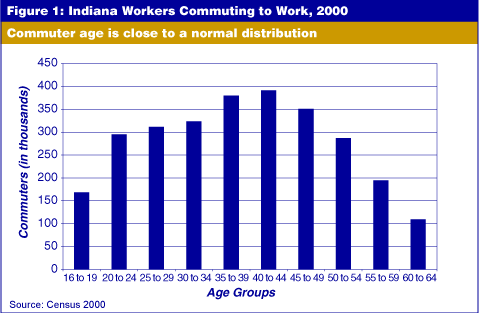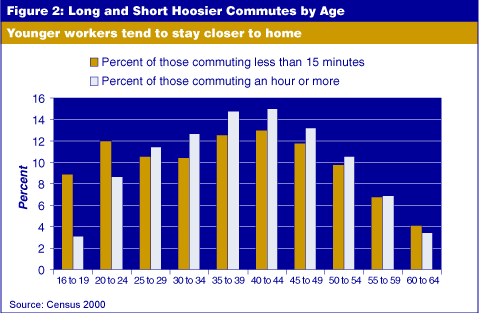How Old Is That Commuter?
It’s interesting to see how distance is sometimes measured in time rather than in length. When it comes to how far one drives to work versus how long it takes to get there, we probably more often talk about the distance as it relates to time. It’s possible to get to downtown Indianapolis from the northwest in no time traveling down I65. Listening to traffic reports though, one would probably need to leave quite a bit earlier to make it downtown from somewhere like Fishers.
If you’ve ever wondered which age group has the longest commutes and which has the shortest, you might be surprised to find that the answer for both is the same. It seems that, of the 2,812,223 employed Hoosiers between ages 16 and 64 who were commuting an hour or more to work in 2000, 40- to 44-year-olds make up the largest group. Of those commuting fewer than 15 minutes, this same group is again the largest. Taking a look at all commuters between the ages of 16 and 64, one finds that the 40- to 44-year-olds make up the largest group in general (see Figure 1). Figure 2 shows the percent breakdown of the shortest and longest commutes by age group.


Historical Censuses Make Good Reading
Did you know that there are actually pages and pages of text, illustrations and maps in the historical census publications? It’s true. Some of these have been scanned by the Census Bureau and are available online. For example, the 10th census (1880) includes a discussion about early iron enterprises in Indiana and Indianapolis. George K. Greene writes that around 1840 “an iron furnace was erected by Randall Ross, of Virginia, on the lands of George Adams, of Monroe County … The investment soon proved a failure, and the furnace has long gone to decay. The ruins of the ‘old iron furnace’ are today the mournful monument of an early spirit of enterprise that deserved a better fate.” The ninth census (1870) includes historical notes on the formation of the territory and state of Indiana. According to the notes, in 1804, “the District of Louisiana, being all of the French cession west of the Mississippi River except the present state of Louisiana, was committed to the government of the officers of the territory of Indiana.” The scanned documents can be found at https://www.archives.gov/research/census, and an index to Indiana-related information found in the 1810 to 1880 censuses is at www.in.gov/library/isdc.htm.
Update on the American Community Survey
The last issue of IN Context reported the uncertain status of the American Community Survey (ACS) due to a possible cut in funding for the program. However, since then the ACS received $146 million for fiscal year 2005 and implementation began in January 2005. The funding allows the Census Bureau to conduct a short-form-only census in 2010 and provide the nation with socio-economic information every year instead of once every 10 years.
Beginning in 2005, a rolling sample of households in all U.S. counties, Puerto Rico and other outlying areas will receive questionnaires each month. The survey collects demographic, socio-economic and housing data—just like data from the long-form questionnaire that has been collected every 10 years. The $146 million is $19 million less than what the president requested, so the implementation of the ACS in group quarters (e.g. college dorms, prisons, nursing homes) will not begin until 2006.
Under the current timetable, data will be available for areas with more than 65,000 inhabitants beginning in the summer of 2006, for areas with 20,000 or more in the summer of 2008, and for all areas—down to census tract level—by the summer of 2010.
By 2010, we will no longer have to wait a decade for up-to-date statistics on our communities. The ACS will provide an annual moving “snapshot” of community characteristics. This will allow legislators, community leaders and businesses access to current data to address a wide range of pressing social and economic issues. To find out more about the ACS, go to www2.census.gov/acs2004/.
The Indiana Data Center Program is a partnership with the U.S. Census Bureau between the Indiana State Library, the Indiana Business Research Center and the Indiana Department of Commerce. There are 57 affiliated data centers throughout Indiana to help assist people locally with their use of census data.
Data Center Contacts:
Jacob Speer, State Librarian: jspeer@library.in.gov
Carol Rogers, IBRC: rogersc@iu.edu
